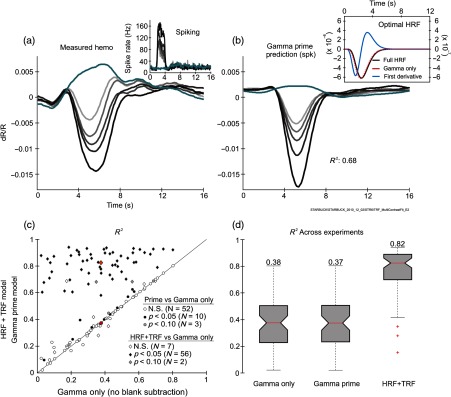Fig. 6.
Gamma prime HRF gives poor fits, with little improvement due to the additional first-derivative term in . (a) Measured hemodynamics. Inset shows concurrent spiking. (b) Optimal prediction from spiking using gamma prime HRF. Inset shows the optimal HRF: both as separate “gamma only” and “first derivative only” components, and added to give the full optimal . Note two different -axis scales: for the full HRF and the gamma only on the left, and for first derivative only on the right. The amplitude of the first derivative only term is an order of magnitude smaller than that of gamma only, making a correspondingly smaller contribution to the prediction. (c) Two sets of pairwise comparisons over the body of experiments to gamma only (i.e., gamma-variate HRF with no TRF and no blank-subtraction). Fits to gamma prime (circles) shows little improvement due to the additional first derivative term in the HRF [Wilcoxon signed rank test: ; red circle: median across experiments (gamma prime: 0.37; gamma only: 0.38, )]. By contrast, fits to HRF+TRF (diamonds) show a striking improvement due to the spike-independent TRF term (Wilcoxon signed rank test: ; red diamond: median across experiments: HRF+TRF: 0.82; gamma only: 0.38; ). and their significance ( values) per experiment calculated using cross validation as in Fig. 5. values color coded as shown in panel key. (d) Box plots showing the same distributions of . Conventions for box plot same as Figs. 4(c1) and 4(c2).

